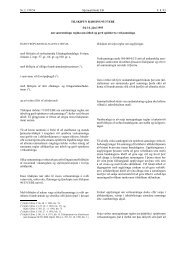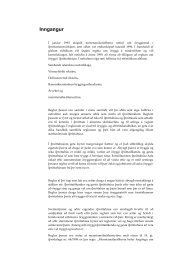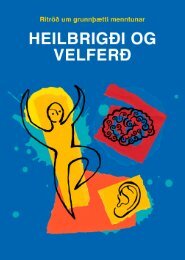Arts and Cultural Education in Iceland : Professor Anne Bamford
Arts and Cultural Education in Iceland : Professor Anne Bamford
Arts and Cultural Education in Iceland : Professor Anne Bamford
You also want an ePaper? Increase the reach of your titles
YUMPU automatically turns print PDFs into web optimized ePapers that Google loves.
tra<strong>in</strong><strong>in</strong>g of senior secondary arts teachers, the opposite is true, with the students ma<strong>in</strong>ly<br />
receiv<strong>in</strong>g theoretical tra<strong>in</strong><strong>in</strong>g with limited or no practical classroom application.<br />
The reductions <strong>in</strong> the time <strong>and</strong> scope of arts <strong>and</strong> cultural education with<strong>in</strong> general teacher<br />
education have made the teacher education <strong>in</strong>stitutions have to develop a sharper focus for<br />
their courses. There has been a steady decl<strong>in</strong>e <strong>in</strong> the amount of arts <strong>and</strong> cultural education<br />
received by tra<strong>in</strong>ee teachers. For example, for pre-school teacher education, the total number of<br />
compulsory ECTs (credit po<strong>in</strong>ts) for the arts <strong>in</strong> 2000-01 academic year <strong>in</strong>take was 27. By 2009-10<br />
this had fallen to 23 ECTs. While this drop is regrettable, the picture is even more pronounced <strong>in</strong><br />
the compulsory, compulsory school tra<strong>in</strong><strong>in</strong>g. In this course, there were 8ects compulsory for all<br />
tra<strong>in</strong>ee teachers for arts <strong>and</strong> cultural education but no compulsory units by 2009-2010. While it<br />
could be argued that the compulsory units have (at least <strong>in</strong> part) been replaced by more optional<br />
units (up to 20 ECTs open choice for general teachers <strong>and</strong> 80 for specialist teachers) this falls<br />
short of a uniform cultural education for all teachers (as is <strong>in</strong>creas<strong>in</strong>gly be<strong>in</strong>g considered a<br />
requirement for teachers <strong>in</strong> the EU). 34 Some respondents blamed the high cost of prepar<strong>in</strong>g arts<br />
educators as the reason why courses had been reduced, as is evident <strong>in</strong> the follow<strong>in</strong>g comment:<br />
The answer is better education for the teachers... but this is chang<strong>in</strong>g fast, to get the artists <strong>in</strong> the schools costs<br />
money... we should discuss how to do this <strong>in</strong> a cheaper way... people don't know what were do<strong>in</strong>g, th<strong>in</strong>k<br />
perhaps we're only decorat<strong>in</strong>g... it's not the conditions only but the m<strong>in</strong>d… They [University of Akureyri] shut the<br />
music teachers dept. down 2006 because of cost. Only three people were allowed to f<strong>in</strong>ish the programme...<br />
only 2 general music teachers with education, 2 others <strong>in</strong>terested.<br />
It was widely reported that there was a shortage of qualified teachers <strong>in</strong> the arts, especially<br />
<strong>in</strong> the woodcraft <strong>and</strong> music areas. As stated by the General Music-Teachers Association; “There<br />
is a lack of qualified teachers. Teachers need to be qualified.” And the follow<strong>in</strong>g comment from<br />
the arts academy; "The most important th<strong>in</strong>g <strong>in</strong> Icel<strong>and</strong> is to improve the general music teacher<br />
education". In music particularly, this shortfall of teachers is be<strong>in</strong>g relieved by <strong>in</strong>ternational<br />
teachers, as the follow<strong>in</strong>g examples shows:<br />
Music school teachers are very <strong>in</strong>ternational. For example, 3 teachers come from Pol<strong>and</strong>; 3 come from Estonia;<br />
<strong>and</strong> one comes from Hungary. It is more difficult to get teachers <strong>in</strong> the regional locations <strong>and</strong> this is where<br />
teachers are most likely to come from any part of the world. Icel<strong>and</strong>ic music is built by foreigners e.g. Austrians,<br />
Czech, Hungarian, F<strong>in</strong>nish musicians. The rock <strong>and</strong> pop music area seemed to be one where there was a<br />
particular shortage of teachers. Pop <strong>and</strong> rock music is a grow<strong>in</strong>g area. Every child wants to be a star <strong>in</strong> a rock<br />
b<strong>and</strong>.<br />
Compulsory schools do not have enough music <strong>in</strong> them. No one wants the hard job of teach<strong>in</strong>g music <strong>in</strong> the<br />
compulsory school. These precious music teachers will not do it; nobody wants to do it. There is also a lack of<br />
dance <strong>and</strong> drama <strong>and</strong> this is a big problem. S<strong>in</strong>g<strong>in</strong>g is also a problem though it depends on the <strong>in</strong>dividual school<br />
<strong>and</strong> their <strong>in</strong>dividual system. Music schools should be made to have to teach <strong>in</strong> the compulsory schools.<br />
We would like to have more dance, but it is difficult to get a teacher...<br />
70% of teachers are foreigners – from Scotl<strong>and</strong>, F<strong>in</strong>l<strong>and</strong> Spa<strong>in</strong>, <strong>and</strong> Lithuania. This is however chang<strong>in</strong>g now.<br />
Five Icel<strong>and</strong>ers have called for a job this fall. This has never happened before.<br />
Pop <strong>and</strong> jazz has been gett<strong>in</strong>g more popular, but difficult to get teachers <strong>in</strong> these areas. Two dance teachers live<br />
<strong>in</strong> Ísafjöður, one from Boston <strong>and</strong> one from F<strong>in</strong>l<strong>and</strong>. The American can't teach all styles like the Icel<strong>and</strong>ers or the<br />
F<strong>in</strong>s.<br />
Figure 5.2.1 shows that 68% of respondents felt that there was <strong>in</strong>sufficient professional<br />
development. Similarly, 25% had difficulties with recruit<strong>in</strong>g qualified staff, while 25% felt that<br />
teacher education did not provide ‘good preparation’ for teachers.<br />
34 Based on figures provided by Anna Kristín Sigurðardóttir Head of the Faculty of Teacher <strong>Education</strong> at the University of<br />
Icel<strong>and</strong>, February 2009.<br />
105



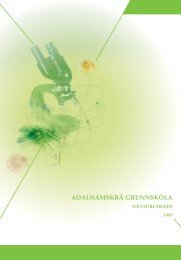
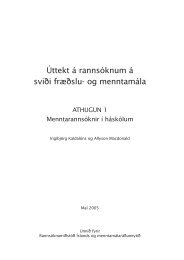

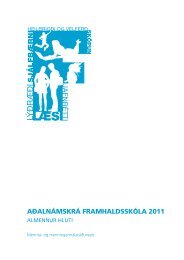
![Aðalnámskrá tónlistarskóla : rytmÃsk tónlist [Eingöngu á rafrænu formi]](https://img.yumpu.com/50843672/1/184x260/aaalnamskra-tanlistarskala-rytma-sk-tanlist-eingangu-a-rafranu-formi.jpg?quality=85)



